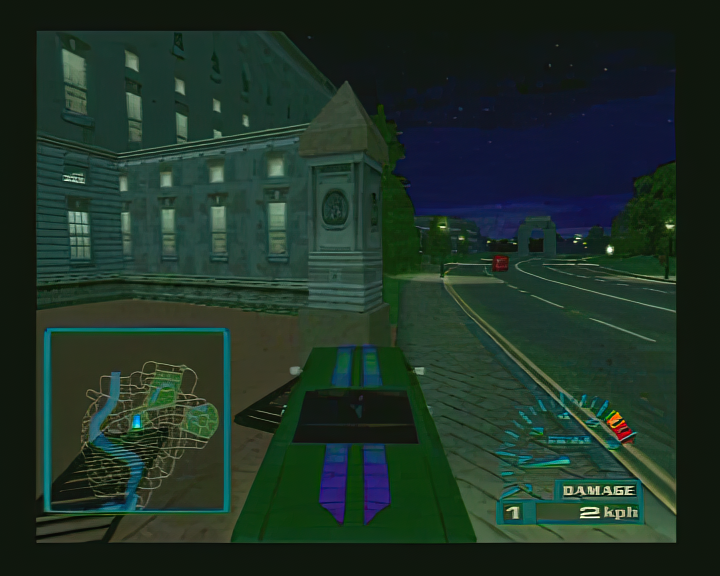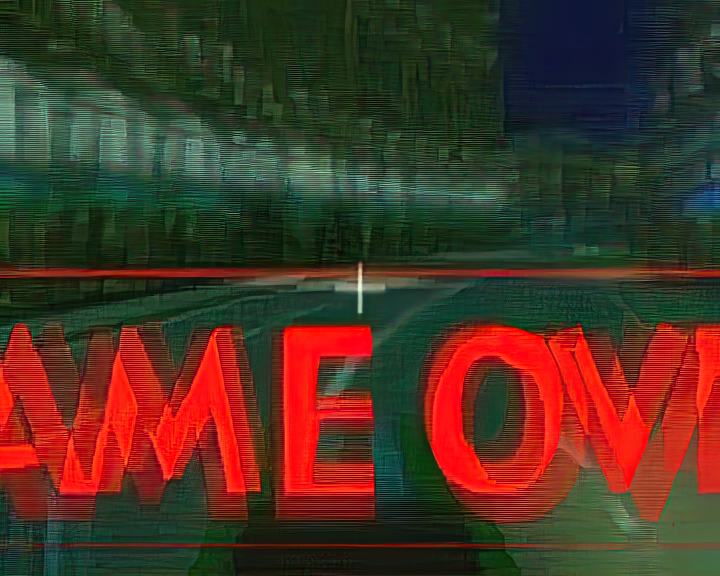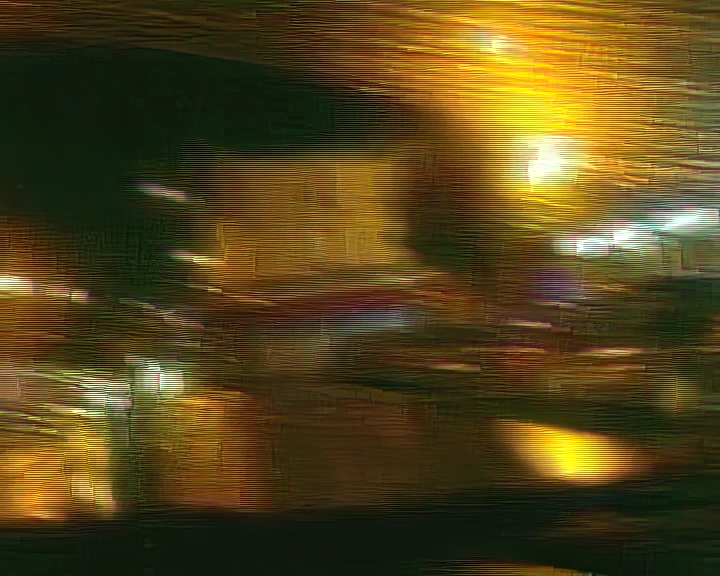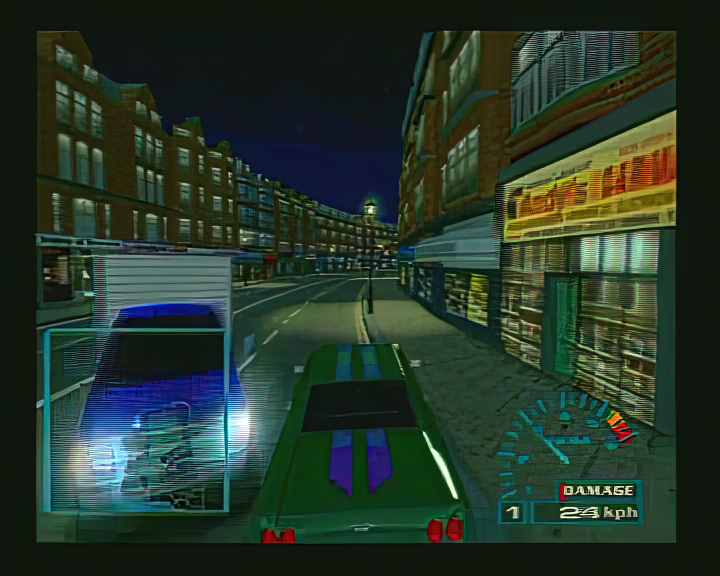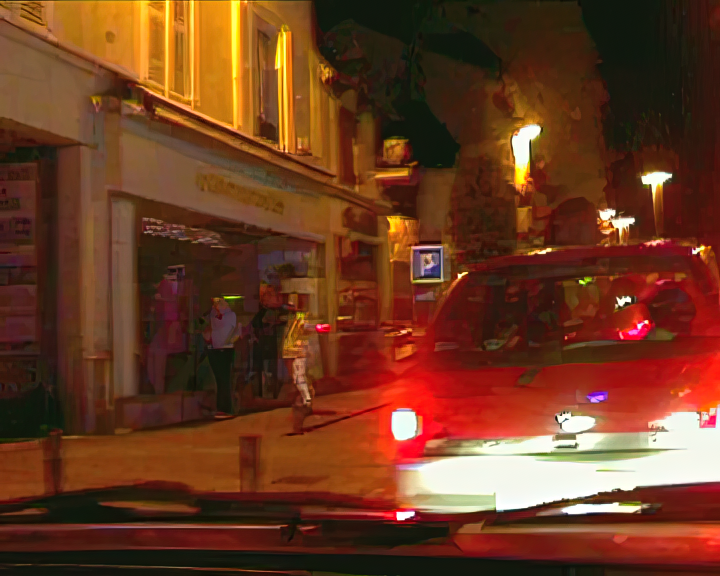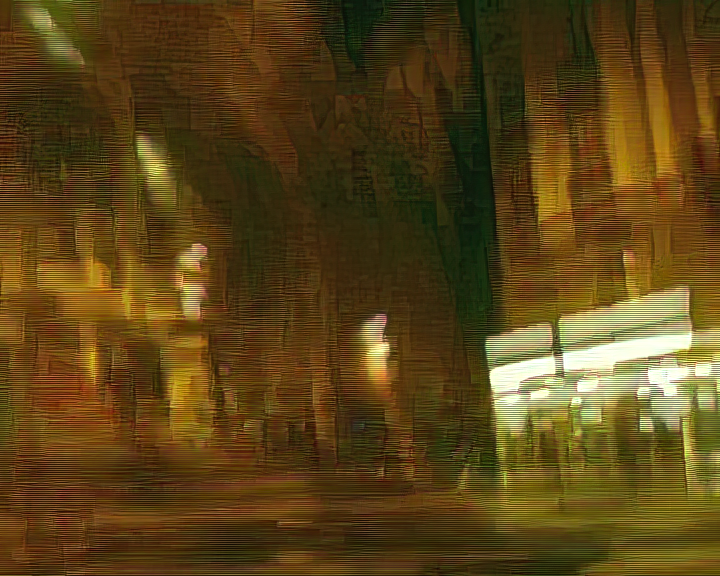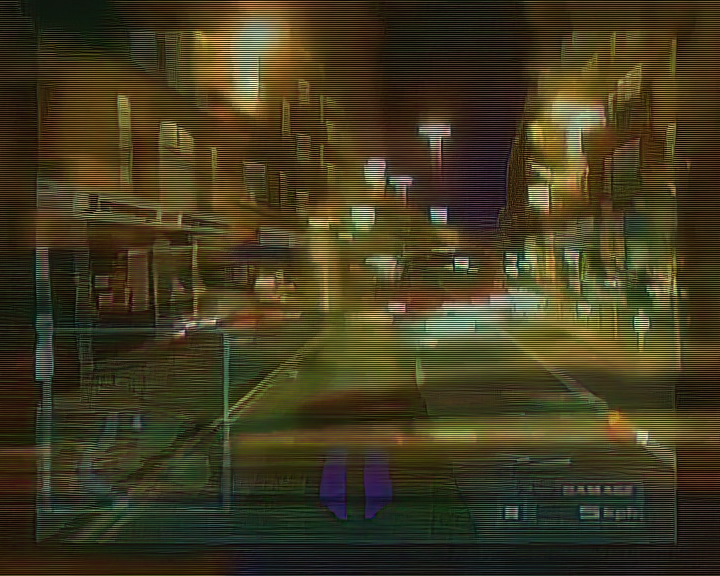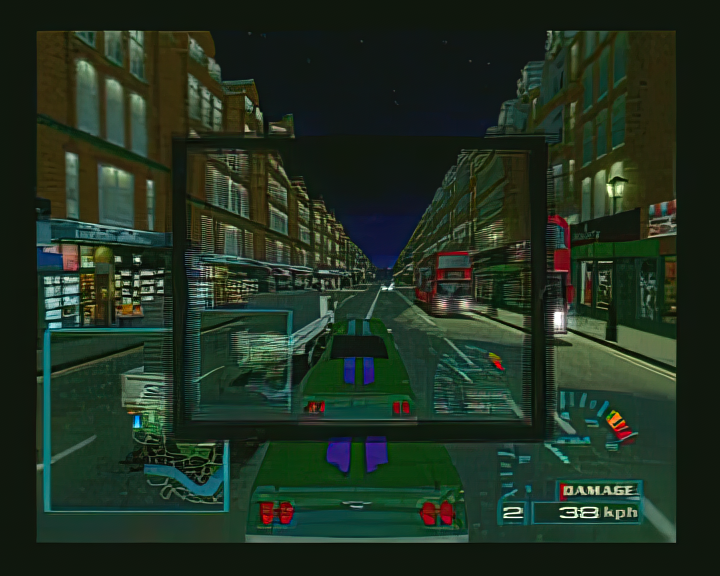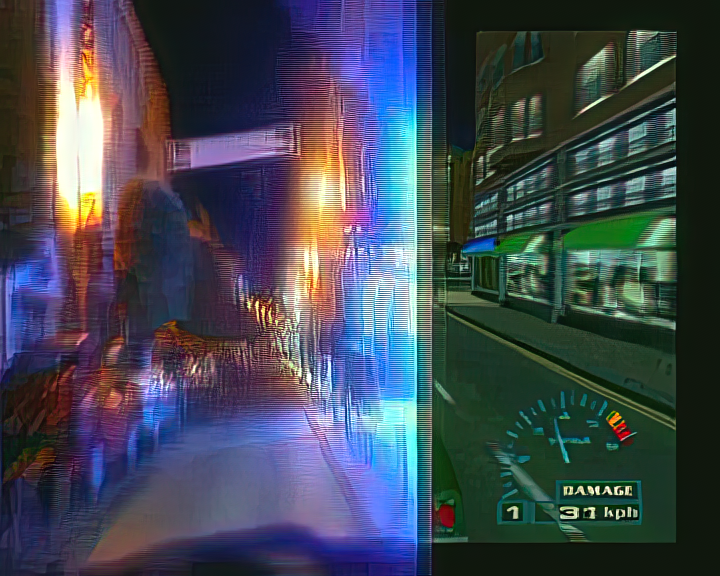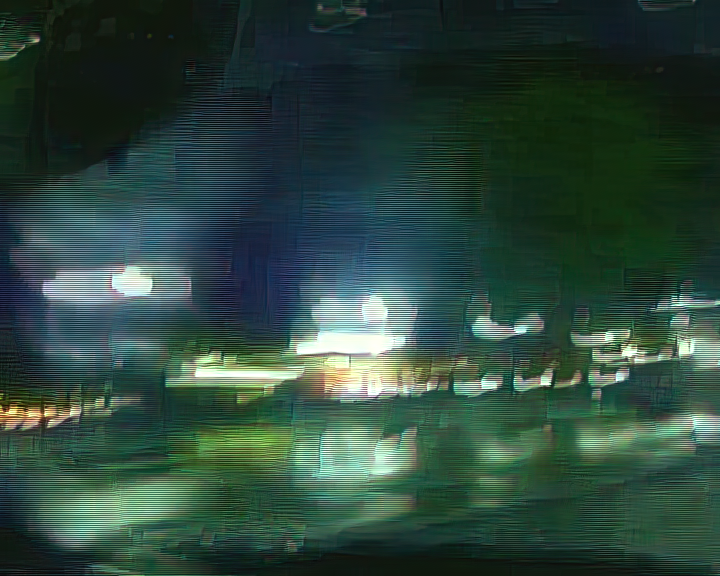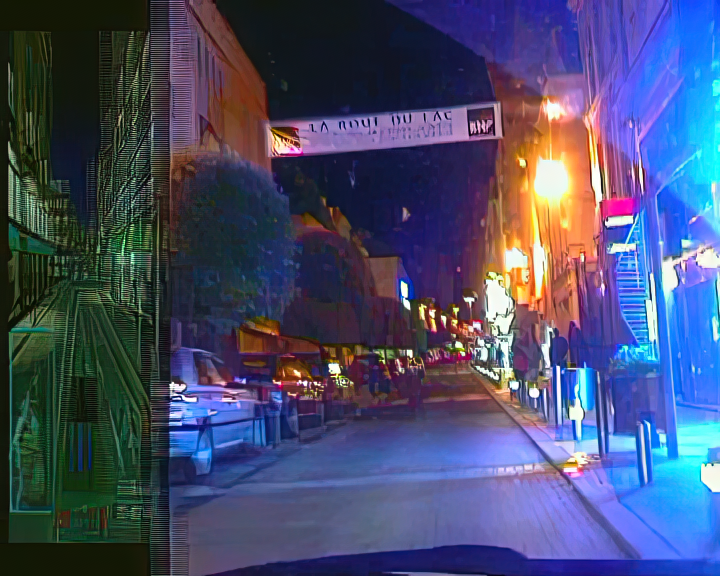GAME OVER
One channel video (SD, 676 x 540), color, sound, 4’ 27”, 2002 Italy
Created by Simonetta Fadda
Driving at night in the video game-like suburban French city of Enghien Les Bains can be an exciting or demoralizing experience, depending on the driver or, perhaps, on the filmmaker. Simonetta Fadda’s carscapes are both delirious and hyper-real, suggesting a toxic convergence of realities.
Born in Savona, Simonetta Fadda is an artist, educator, essayist, and translator. Her teaching activities include the Accademia Albertina di Belle Arti, Turin and Accademia di Belle Arti di Brera, Milan. Since the Eighties, she has been working with video art. Her artworks are featured in public and private collections in Italy and in Europe. She participated in major international events such as Movimenta – Biennale de l’image en mouvement, projet Mondes Flottants: Grandes Images, Nice, France (2017) and Parallel Program of the 13th Istanbul Biennial, Institut Français d’Istanbul, Istanbul (2013). In Italy she was featured, among others, at Festival del Nuovo Cinema di Pesaro, Pesaro – Italy (in We Want Cinema: cinema e video di ricerca 2018, and in Satellite 2016) and Bergamo Film Meeting, Bergamo – Italy (2010). A prolific writer and critic, Fadda is the author of the seminal Definition zero: origins of video art between politics and communication (Costa & Nolan, 1999), the first Italian study on video as a medium of art and political activism, which was reprinted in an expanded format in 2017 by Meltemi Edizioni. In 2020, Franco Angeli published her new book, Media and art. She also translated into Italian and edited Gene Youngblood’s seminal book Expanded Cinema.
Italian below
Matteo Bittanti: Generally, machinima and video art are considered two related but distinct forms of digital video production. Machinima is a form of filmmaking that uses real-time computer graphics engines, typically from video games, to create animated movies. Machinima often involves repurposing existing game environments and assets to create new narratives and characters, and can range from comedic shorts to dramatic epics. Machinima is often associated with the gaming community and has been used as a tool for both entertainment and artistic expression. Video art, on the other hand, is a broader category of artistic expression that uses video and digital technologies to explore a range of themes and concepts. Video art can encompass a wide variety of styles, techniques, and approaches, from experimental narratives to abstract compositions. However, as I argued elsewhere, I consider avant-garde and experimental machinima a genre of video art, and thus, a form of contemporary art. Unlike vernacular machinima, avant-garde machinima is not created with entertainment in mind: it is used as a tool for artistic expression and experimentation to explore themes related to identity, politics, environmental and social issues. Like video art, avant-garde machinima is not bound to a specific narrative-driven approach. As an artist and a researcher, what is your take on machinima? What is machinima to you and how does it relate to video art? Do you think that the intrinsic cinematic element of machinima is stronger than any of its artistic aspirations?
Simonetta Fadda: The key word, as you mention, is “entertainment.” Entertainment produces a predetermined effect, a result known from the very beginning. When we get entertained, after all, we already know the end point. We choose entertainment for that specific reason. Entertainment is reassuring. It gets us into a circumscribed space-time whose boundaries are already known and to which we surrender gratefully. In contrast, the impact of a work of art is always unpredictable, since art speaks to everyone differently. Art is about freedom. A work of art opens up a space of freedom for its audience, allowing one to engage in an intimate dialogue with themselves, which could eventually lead to the discovery of unknown, overlooked truths. Art produces a disturbing vertigo. One could even say that art is just a conduit, a bridge connecting us to the depths lurking within each of us, where the work eventually disappears. So, as for the difference in general between what is art and what is not, it all depends on the intentions and goals guiding the author/artist in their creative process and not on the techniques and forms they use. Then, with regard to machinima experimentation in particular – I like to use the word “machinima” as an adjective –, I agree that it is a way of making art in which we appropriate existing artificial scenarios and implode them into narratives and situations that challenge our real world. Again, because of that aspect of freedom that is inherent in art, I wonder if it wouldn’t be better to shift our point of view slightly. Instead of considering it a genre, perhaps we should consider machinima a technique. I think it would be profoundly liberating, in order to disenfranchise machinima from the context of the gamer community, to start talking about machinima the way we talk about watercolor, just as an example. It is not the watercolor that defines a particular painting, but it is what that particular painting shows us that does. If then, we are so “fixated” that we also want to understand how that painting was made, we go and read the caption (where we finally find the word “watercolor”), however, it is not essential to do so. So, in general, for me and my art practice, machinima is one technique among many others. After all, today “you can make art with anything,” the important thing is the result on the level of meaning. Likewise, I think it is useful to spread machinima works in bursts within dedicated art contexts, precisely to “naturalize” their presence for the public. In particular, I think it is important to do this within the Italian context, whose artworld is often parochial. However, I think it would be even better to encourage their dissemination in a disguised way, without using the term “machinima.” I am overjoyed when I see these works within spaces dedicated to art, or film experimentation, where they also show anything else, because it means that the ghetto of the gamer community has been definitively abandoned. It is only in this way that critics who are completely ignorant about the world of video gaming, while being somewhat displaced by what they are seeing, turn out to welcome it anyway, because they do not feel rejected by a community that is not their own. Again, if we consider the Italian context, this has happened recently, for example, when an artwork by Total Refusal screened at Filmmaker 2022 won the jury prize; I remember perfectly well the embarrassment of the critic presenting that work to the audience, after the screening: not only did he not understand how one could intervene from the inside in an existing video game, but he did not even know of the existence of Grand Theft Auto! Nonetheless, you could see how favorably impressed he was by what he had seen, and that was the really important thing, not his technical expertise on video games. If we look outside of Italy, at a more international context, a work such as Everywhere di Søren Thilo Funder, the moment it was projected on the facade of a building in New York, in 2013, took on a whole other meaning, since in this way it showed to people even less interested in art, how reality – the incessant swarming of the New York crowd, trapped in the rhythms of work – is a kind of video game. In short, in my opinion, machinima experimentation opens up very interesting scenarios for more critical art, but forcing these works within the grid of an art genre limits their scope. By the way, considering machinima only a technique would also help to more easily discriminate artworks that draw on this technique, what you call avant-garde machinima, from productions based on video games just for the “love of the video game,” but unable to transcend gamer passion. It might help to mark a distance, somewhat like the blatant and obvious one between fan films published on online platforms, which only succeed in celebrating existing films from the mainstream circuit, versus artworks that use found footage to construct highly effective and linguistically innovative critiques.
Matteo Bittanti: Can you describe the origins of Game Over? The juxtaposition of video game gameplay and live footage suggests a compare-and-contrast approach, but also a possible convergence, as if everyday “reality” has been replaced by “gaming” and we now live in a Baudrillardian, hyperreal world. What was your creative process? Can you share your original intention?
Simonetta Fadda: Game Over was created specifically for an exhibition to which I had been invited, the fourth edition of the Biennial in Enghien Les Bains, a spa resort with a casino, near Paris. The theme of the show was “Landscapes.” So, I went to Enghien to figure out what to do. As soon as I arrived, I realized that it was a place where it was necessary to have a car to do anything. There was no public transportation in town, and getting around on foot had quickly proved to be quite tiring. In the evening, the station connecting to Paris closed. In short, it was a complete disaster. To get a better sense of this sad state of affairs, I convinced the critic who had invited me to drive me through the streets of the little town at night, while I filmed the experience. The night in that deserted place was so alienating, it gave me the idea of being sucked into an artificial world over which I had no control. Back in Milan, I began to scramble to illustrate the horrific feeling I had experienced during that long night drive. I had immediately realized that I needed a video game that simulated driving a car, but I am not a gamer myself. Eventually, I found a video artist friend who was generous enough to record a session of a racing game for me. The sequel is a lot of fun. This friend of mine had in turn engaged her friend to play the game for her. Only her friend did not have a driver’s license, nor had she ever tried to play a video game. When they gave me the recorded materials, it was a real revelation to me: one incident after another, all of them as daring as they were impossible. I couldn’t have hoped for better! It was all so absurd, just like what I had experienced that night riding the car in Enghien Les Bains! At that point, editing was a breeze. The overlap between the real and the artificial felt so absurdly natural. Even the architecture was similar. I remember laughing as I produced my work. Yes, I am convinced that ours has in every way become the world prophetically described by Baudrillard, but I think it is in such an exaggerated way that often, when we manage to gain the right ironic distance, its claustrophobic feeling suddenly dissolves. My purpose, in Game Over, was to bring out the extent to which our lived reality has been transformed into a kind of video game, itself a Baudrillardian idea, and I am convinced that whatever machinima material I had at my disposal, I could have brought this out in my editing, which from the beginning I had decided to base on an overlap between a real car ride at the exhibition sites and a simulated car ride. The fact that the recording of the car session in the video game was so paradoxical in itself only made my work more fun while doing it. In addition, I am convinced that randomness is a fundamental component of art, something precious that one must be able to embrace precisely because of the unexpected openings it opens up. Relying on an external factor — in this case someone else to play the video game —, was an integral part of this game that I actually always play to myself. It is a kind of challenge that I address to myself every time I set out to make a new work: I always look for an unforeseen stimulus, not determined by me, that can direct my work toward forms that I would not have practiced if I had relied on myself alone.
Matteo Bittanti: Game Over reminds me of Kristin Lucas’s BLAM! (2000) an interactive installation titled Temporary Housing for the Despondent Virtual Citizen, which was subsequently presented as a one channel video in the group exhibition Travelogue (2016), in Mantua, Italy. BLAM! depicts the artist playing a racing game under duress. Constantly distracted by a stream of information and unrelentless interruptions, the player is struck in the chaotic space of a racing game. Overwhelmed by stimuli, she expresses her fears of reaching a “saturation point” while cars roam the streets of a generic American city. The same kind of stress, overstimulation, and reckless driving is at play in Game Over. What is your relationship to driving, especially in the Italian context, where recklessness, unruliness and even road rage seem to be the default, given the inertia of the so-called police officers? Was Game Over first and foremost a work of social criticism?
Simonetta Fadda: I have always compared driving a car to watching a movie. Behind the windshield we are sitting before a screen, which is why driving can easily change our personalities, even going so far as to turn ourselves into aggressive and impatient beings, something that we would not do outside of this carapace. In our car, we are inside a movie, and everything seems somehow unreal to us, a fiction. It is a very dangerous feeling, however: looking at the world through the windshield makes us all victims of this illusion. In Game Over this aspect is emphasized, but not as conscious, deliberate social criticism on my part. Rather, it is the will to dominance expressed by the artificial control over space, enacted by speed, that is at the center of my work, which, in fact, shows how that control over space is only an arrogant conceit, destined to break down. It is more an argument about the hubris of the ubermensch, which leads us to be blind to our human limits and the limits of the world that hosts us. What the Greeks called hybris and is now the basic rule of our living in the world. The feeling of being inside a movie, at the moment of driving a car, was certainly the initial stimulus that led me to decide to record on video the nighttime drive through the streets of Enghien. Somehow, in my videos, one of the questions I always try to address is what sense working with moving sound images makes in our world, and my answers are determined by the forms I adopt from time to time, as well as the choice of images to show. In this case, my thoughts in this regard took place in the comparison between the mental film of someone driving a real car and the equally mental film of someone driving a car in the simulated world of the video game.
Matteo Bittanti: You created several video and photography installations that explore the ways in which digital media can shape our perceptions of reality, as well as the relationship between the virtual and physical worlds. How would you use video games in your epistemological exploration of the world?
Simonetta Fadda: One element that I find very intriguing is the claustrophobia typical of any video game. In a film, what is seen is in perpetual dialogue with what is not seen. The off-screen is always evoked and is something materially present in the scene. In this way, the film is not only what appears on the screen. The viewer of a film must mentally and autonomously create everything that does not take shape directly on the screen, because it is what does not appear that gives meaning to what appears. In a video game, on the other hand, everything that is not seen and then appears is always as if it materialized unexpectedly, almost by accident, but at the same time it is as if it was always there. That shot came from the right, but it could also have come from the left. I, however, knew both that it would come from the right and that it could also have come from the left, and I was ready. That character starts to move, but he could also have stayed still, in any case he was there even when I didn't realize it. In a video game it’s already all inside the screen where I have the illusion of moving as I want because of the console, even though I know I'm not going anywhere. There is no world outside that screen, a world that I have to necessarily conjure up to make sense of what I see. This is it, the claustrophobia I feel: a universe closed and concluded in itself, in which we become similar to the hamster that keeps running by spinning the wheel of its cage, never stopping. Undoubtedly, this exerts a deep fascination. If nothing else, because it resets time to zero, crystallizes it into a single eternal present. Then, the feeling of having everything under control: the vertigo of domination of patriarchal-capitalist ideology is realized in which everything I see is there only for me and in function of what I do, in my service. Certainly, these are aspects I would like to reason about, but not being a video gamer I prefer to preserve my own naïve approach to video games, to let “outsider” impressions and feelings take over. I think on an epistemological level this naïve point of view can be very valuable. In particular, however, the fact that I am not a “gamer” I think also has to do with the belief that reality is increasingly being modeled on video games. It is not the video game that takes its cue from the world, but the world that increasingly functions as a video game. This aspect underlies my fascination with video games, but it also has to do with a strongly perturbing feeling. It is the claustrophobia evident in the video game, which I find in a chilling way in the real world. This claustrophobia is nothing more than our inability, or impossibility, to imagine a viable way out of the global oppression of a system of economic exploitation of individuals and resources that condemns us to the misery of wars and climate change. As Mark Fisher has long recognized, “it is easier to imagine the end of the world than the end of capitalism.” I try to retain an optimism in spite of it all, I keep striving to imagine possibilities for initiating change, and perhaps, paradoxically, it is this optimism and the race against time it produces that prevents me from introducing the video game as a leisure interlude in my life, despite the fact that I have chosen it as one of the most theoretically fruitful objects for tracing the hypotheses for change that it is so necessary to strive to imagine today.
Matteo Bittanti: Your teaching approach in some of Italy’s most remarkable art institutions involves working closely with the students to develop projects that explore the intersections between art and other disciplines, such as science, technology, and architecture. You encourage your students to experiment with a wide range of media and forms, and to approach their work with a spirit of curiosity and innovation. What was it like to introduce video games and machinima as part of the curriculum? What kind of feedback did you receive?
Simonetta Fadda: Regarding theoretical work with machinima, in my classes the return is always very satisfying. Students and students do not expect that the video games they play can be cues for complex artistic operations, and when I introduce the topic in class, I see that a new, very stimulating world opens up for them. Suddenly, they discover that they possess a language, where they thought they had only a craze, a passion that stole space from serious things. Possessing a language and being able to speak it well are two separate things, but I see that there are several students and female students who take their cues from machinima experiments to set out on the same path. The most interesting thing, for me, is that I have everything to learn from them in this field. It always works that way, between faculty and students, but in this case it happens even more. And that is also very encouraging for them. In my opinion, then, machinima experimentation opens up an ecological perspective in working with moving sound images, as found footage also does, after all: instead of giving in to image bulimia, creating more and more images, they take existing ones into account, to illuminate them with new perspectives of meaning. I don’t know to what extent it can solve the problem of “computer waste,” but it is nonetheless a way to start thinking about this problem as well.
Matteo Bittanti: Among other things, You translated and edited the Italian version of a seminal text, Gene Younblood’s Expanded Cinema, a term which refers to forms of experimental film that explores the potential of cinema to become a more immersive and interactive art form, incorporating new technologies and performance elements to create a more dynamic relationship between the audience and the artwork. Would you consider machinima an example of Expanded Cinema or not, considering its lack of interactivity, which in the 1970s, was considered an emancipatory form of engagement with the artwork, whereas today interactivity has completely lost its luster? After all, in the afterword of the Italian edition of Expanded Cinema, you wrote “in the expansion of our consciousness we no longer feel free, as Youngblood imagined in 1970, but otherwise even more controlled and “played” from the outside’.”
Simonetta Fadda: Properly framing the difference between interaction, participation and interactivity today is crucial. Sometimes, I ask my students to reason about interaction and participation and write down their personal definitions about it. Incredibly, for them “interaction” means tout court “interactivity,” as if they were synonyms. From their perspective, then, “interactivity” is something richer than “participation,” which they read as being a spectator of something. For interactivity, they give the example of social networks, while for participation the most common example is “attending a conference.” They do not realize that their actions on social media, or at any rate their paths on the web, are possible only within a defined and limited, though very wide, range of possibilities. Just as they do not realize that, on the opposite end of the spectrum, participating in something allows the creation of something new, not initially envisioned. Here, we can fully realize how distant we are from the 1960s, when Youngblood wrote his text. At that time, “participation” was a kind of buzzword, a passkey for physical and mental access to the new worlds that were being experimented with. Today, the spaces for experimentation seem to have narrowed dramatically. In this sense, machinima, as an experimental technique that makes it possible to parasitically use the artificial scenarios of video games, transforming them into powerful critical weapons, rather than being seen as a form of expanded cinema, in my opinion can perhaps be framed as an accomplished form of post cinema that knows how to create alternative non-narratives from existing pseudo narratives.
Matteo Bittanti: In generale, il machinima e la videoarte sono considerati due forme correlate ma distinte di produzione video digitale. Il machinima è una forma di filmmaking che utilizza motori di grafica computerizzata in tempo reale, generalmente provenienti da videogiochi, per creare film d’animazione. Il machinima spesso consiste nel riutilizzare ambienti e risorse di gioco esistenti per creare nuove narrazioni e personaggi, e può spaziare da cortometraggi comici a epopee drammatiche. Il machinima è spesso associato alla comunità dei videogiochi ed è stato utilizzato come strumento di intrattenimento e di espressione artistica. La videoarte, invece, è una categoria più ampia di espressione artistica che utilizza le tecnologie video e digitali per esplorare numerosi temi e concetti. La videoarte può comprendere un’ampia varietà di stili, tecniche e approcci, dalle narrazioni sperimentali alle composizioni astratte. Tuttavia, il machinima sperimentale e d’avanguardia può essere considerato un genere di videoarte, e quindi una forma di arte contemporanea. A differenza del machinima vernacolare, il machinima d’avanguardia non è creato con l’obiettivo di intrattenere: è usato come strumento di espressione artistica e di sperimentazione per esplorare temi legati all’identità, alla politica, alle questioni ambientali e sociali. Come la videoarte, il machinima d’avanguardia non è legato a un approccio narrativo specifico. Nel doppio ruolo di artista e ricercatore, qual è il tuo punto di vista sul machinima? Che cos’è il machinima per te? Come si relaziona alla videoarte? Ritieni che l’elemento cinematografico intrinseco del machinima sia più forte di qualsiasi aspirazione artistica?
Simonetta Fadda: La parola chiave, come hai già detto tu, è “intrattenimento”. L’intrattenimento produce un effetto prestabilito, calcolato in partenza. Quando ci facciamo intrattenere, in fondo, sappiamo già dove stiamo andando. Scegliamo l’intrattenimento proprio per questo. L’intrattenimento è rassicurante. Ci fa entrare in uno spazio-tempo circoscritto di cui conosciamo già i confini e nel quale ci abbandoniamo con gratitudine. Invece, l’impatto di un’opera d’arte è sempre qualcosa d’imprevedibile, dal momento che l’arte parla a ognuno in modo diverso. È tutta una questione di libertà. Un’opera d’arte apre al suo pubblico uno spazio di libertà che gli permette di entrare in un dialogo intimo con se stesso, al punto di arrivare a scoprire aspetti sconosciuti e impensati di sé. È una vertigine in qualche modo disturbante. Si potrebbe addirittura affermare che l’arte è solo un tramite, un ponte per attingere alle profondità che si annidano dentro ognuno di noi, dove l’opera alla fine scompare. Quindi, per quanto riguarda la differenza in generale tra ciò che è arte e ciò che non lo è, tutto dipende dagli obiettivi che guidano l’autore/artista nella creazione e non dalle tecniche e dalle forme utilizzate. Poi, per quanto riguarda in particolare la sperimentazione machinima (mi piace declinare la parola “machinima” come aggettivo), sono d’accordo che sia un modo per fare arte, in cui ci si appropria di scenari artificiali esistenti per farli implodere in narrazioni e figure che mettono pesantemente in discussione il nostro mondo reale. Sempre per quell’aspetto di libertà che è proprio dell’arte, mi chiedo se non sarebbe meglio spostare leggermente il nostro punto di vista. Invece di considerarlo un genere, forse bisognerebbe considerare il machinima una tecnica. Penso che sarebbe profondamente liberatorio, per affrancare il machinima dal contesto della gamer community, iniziare a parlare di machinima come si parla dell’acquerello, tanto per fare un esempio. Non è l’acquerello a definire un particolare dipinto, ma è ciò che quel particolare dipinto ci mostra, a farlo. Se poi, siamo così “fissati” da voler anche capire come è stato realizzato quel quadro, andiamo a leggere la didascalia (dove troviamo finalmente la parola “acquerello”), però non è fondamentale farlo. Perciò, in linea generale, per me e per la mia pratica artistica, il machinima è una tecnica tra le altre. Del resto, oggi “si può far arte con tutto”, l’importante è il risultato sul piano del senso. Allo stesso modo, credo sia utile diffondere a raffica all’interno di contesti artistici dedicati le opere machinima, proprio per “naturalizzare” la loro presenza per il pubblico. In particolare, credo sia importante farlo all’interno del contesto italiano, in cui il mondo dell’arte è spesso provinciale. Tuttavia, credo che sarebbe ancora meglio favorire la loro disseminazione in modo dissimulato, senza nemmeno utilizzare il termine “machinima”. Sono felicissima quando vedo queste opere all’interno di spazi dedicati all’arte, o alla sperimentazione cinematografica, dove si mostra anche tutt’altro, perché significa che il ghetto della gamer community è stato definitivamente abbandonato. Solo in questo modo, critici completamente ignoranti sul mondo del videogioco, pur restando un po’ spiazzati da quello che stanno vedendo, si rivelano capaci di accoglierlo lo stesso, perché non si sentono respinti da una community che non è la loro. Sempre guardando al contesto italiano, questo (è successo di recente, per esempio, con un lavoro di Total Refusal presentato all’edizione 2022 di Filmmaker, che ha vinto il premio della giuria; ricordo perfettamente l’imbarazzo del critico che presentava quel lavoro al pubblico, dopo la proiezione nell’ambito del concorso: non solo non capiva come si potesse intervenire dall’interno in un videogioco esistente, ma non sapeva nemmeno dell’esistenza di Grand Theft Auto, però si vedeva quanto fosse rimasto favorevolmente colpito da quello che aveva visto e questa era la cosa davvero importante, non la sua competenza tecnica sui videogiochi. Guardando invece all’ambito internazionale, un lavoro come Everywhere di Søren Thilo Funder (presentato anche su VRAL di recente , nel momento in cui è stato proiettato sulla facciata di un palazzo (New York, 2013) ha assunto tutta un’altra consistenza, poiché in questo modo ha mostrato con evidenza anche alle persone meno interessate all’arte, come la realtà – il brulichio incessante della folla newyorkese, intrappolata nei ritmi del lavoro –, sia una specie di videogioco. In sintesi, a mio parere la sperimentazione machinima apre scenari interessantissimi all’arte più critica, ma costringere queste opere all’interno della griglia di un “genere artistico” ne limita la portata. Tra l’altro, considerare il machinima solo una tecnica, aiuterebbe anche a discriminare con maggiore facilità le opere d’arte che attingono a questa tecnica, quelle che tu definisci machinima avant-garde, dalle produzioni basate sui videogiochi solo per “amore del videogioco”, ma incapaci di andare oltre la passione da gamer. Potrebbe aiutare a marcare una distanza, un po’ come quella palese ed evidente tra i fan film pubblicati sulle piattaforme online, che riescono solo a celebrare i film esistenti del circuito mainstream, rispetto alle opere d’arte che utilizzano il found footage per costruire critiche efficacissime e innovative sul piano linguistico.
Matteo Bittanti: Puoi descrivere le origini di Game Over? La giustapposizione tra il gameplay videoludico e le riprese dal vivo suggerisce un approccio comparativo, ma anche una convergenza tra due estetiche ed epistemologie, come se la “realtà” di tutti i giorni fosse stata sostituita dal “gioco” e ora vivessimo in un mondo baudrillardiano, iperreale. Qual era il tuo processo creativo e l’intento originale?
Simonetta Fadda: Game Over è stato creato appositamente per una mostra a cui ero stata invitata, la quarta edizione della Biennale di Enghien Les Bains, una stazione termale dotata di Casinò, vicino a Parigi. Il tema con cui dovevo misurarmi era “paesaggi”. Così, ero andata a Enghien per capire cosa fare. Appena arrivata, avevo capito che era un posto dove era necessario avere un’auto per fare qualsiasi cosa. Non c’erano mezzi pubblici nella cittadina e girarla a piedi si era subito rivelato piuttosto faticoso. La sera, poi, la stazione che collegava a Parigi chiudeva. Un disastro. Per capire ancora meglio la situazione, convinsi il critico che mi aveva invitato a scarrozzarmi di notte per le vie della cittadina, mentre io riprendevo in video il nostro tragitto in auto. Ricordo che la notte in quel luogo deserto era talmente straniante, da darmi l’idea di essere stata risucchiata in un mondo artificiale su cui non avevo controllo. Tornata a Milano, iniziai a darmi da fare per far emergere la sensazione un po’ horror che avevo provato in quel lungo giro notturno. Avevo immediatamente capito che mi ci voleva un videogioco che simulasse la guida di un’auto, ma io non sono una videogiocatrice. Alla fine, trovai un amico videoartista che s’impegnò a registrarmi una sessione di un videogioco di auto. Il seguito è molto divertente. Questo mio amico aveva a sua volta coinvolto una sua amica a giocare al posto suo. Solo che la sua amica non aveva la patente, né aveva mai provato a giocare a un videogioco. Quando mi diedero i materiali registrati, per me fu un’autentica rivelazione: un incidente dietro l’altro, tutti tanto rocamboleschi quanto impossibili. Non avrei potuto sperare di meglio! Era tutto così assurdo, proprio come quello che avevo provato io quella notte in auto a Enghien Les Bains! A quel punto, il montaggio fu un gioco da ragazzi. La sovrapposizione reale/artificiale era così assurdamente naturale! Persino le architetture erano simili. Ricordo che continuavo a ridere mentre lavoravo. Sì, sono convinta che il nostro sia diventato in tutto e per tutto il mondo profeticamente descritto da Baudrillard, ma penso che lo sia in un modo così esagerato, che spesso, quando riusciamo a guadagnare la giusta distanza ironica, la claustrofobia che sembra caratterizzarlo improvvisamente si dissolve. La mia finalità, in Game Over, era far emergere fino a che punto la nostra realtà vissuta si sia trasformata in una specie di videogioco (che in effetti è un’idea molto beaudrillardiana) e sono convinta che qualsiasi fosse stato il materiale machinima a mia disposizione, avrei potuto far venir fuori questo aspetto nel mio montaggio (che fin dall’inizio avevo deciso di basare su una sovrapposizione tra un giro in auto reale nei luoghi della mostra e un giro in auto simulato). Il fatto che la registrazione della sessione in auto nel videogioco sia stata di suo così paradossale, non ha fatto altro che rendere più divertente il mio lavoro, mentre lo facevo. In più, sono convinta che l’aleatorietà sia una componente fondamentale dell’arte, qualcosa di prezioso che bisogna saper accogliere proprio per le aperture impreviste che dischiude. Affidarmi a un fattore esterno (in questo caso qualcun altro al posto mio per giocare al videogioco), era parte integrante di questo gioco che a dire il vero faccio sempre tra me e me. È una specie di sfida che mi rivolgo ogni volta che mi accingo a realizzare una nuova opera: cerco sempre uno stimolo imprevisto, non determinato da me, che possa indirizzare il mio lavoro verso forme che non avrei praticato, se avessi fatto affidamento solo su di me.
Matteo Bittanti: Game Over mi ricorda BLAM! (2000) di Kristin Lucas, una componente dell’installazione interattiva intitolata Temporary Housing for the Despondent Virtual Citizen, successivamente presentata come video monocanale nella mostra collettiva Travelogue (2016), a Mantova, Italia. BLAM! ritrae l’artista mentre gioca a un gioco di corse sotto costrizione. Costantemente distratto da un flusso di informazioni e interruzioni incessanti, il giocatore è colpito nello spazio caotico di un gioco di corse. Sopraffatta dagli stimoli, l’artista esprime il timore di raggiungere un “punto di saturazione” mentre le auto vagano per le strade di una generica città americana. Lo stesso tipo di stress, sovrastimolazione e guida spericolata è in gioco in Game Over. Qual è il tuo rapporto con la guida, soprattutto nel contesto italiano, dove la spericolatezza, la sregolatezza e persino la rabbia stradale sono la norma, anche per via della nota inerzia delle forze dell’ordine? Game Over è innanzitutto un’espressione di critica sociale?
Simonetta Fadda: Ho sempre assimilato guidare l’automobile a vedere un film. Dietro al parabrezza siamo davanti a uno schermo, per questo alla guida cambiamo così facilmente personalità, arrivando persino a permetterci aggressività e sregolatezze che fuori dall’auto non useremmo mai. Dentro l’automobile siamo dentro a un film e tutto ci sembra in qualche modo irreale, proprio come in un film. Una sensazione pericolosissima, però ne siamo tutti in qualche modo vittime, quando guardiamo il mondo dal parabrezza. In Game Over questo aspetto è enfatizzato, ma non come critica sociale consapevole, da parte mia. Piuttosto, è la volontà di dominio espressa dal controllo artificiale sullo spazio, messo in scena dalla velocità, a essere al centro del mio lavoro che, infatti, mostra come quel controllo sullo spazio sia solo un’arrogante presunzione, destinata a infrangersi. È più un ragionamento sulla tracotanza del nostro superomismo, che ci porta a non vedere i nostri limiti umani e i limiti del mondo che ci ospita. Quella che i Greci chiamavano hybris e che ora è la regola base del nostro vivere nel mondo. La sensazione di essere dentro a un film, nel momento in cui si guida un’auto, è stata senz’altro lo stimolo iniziale che mi ha portato a decidere di registrare in video la scarrozzata notturna per le strade di Enghien. In qualche modo, nei miei video una delle domande a cui cerco sempre di rispondere è che senso abbia il lavoro con le immagini sonore in movimento nel nostro mondo e le mie risposte sono determinate dalle forme che adotto di volta in volta, oltre che dalla scelta delle immagini da mostrare. In questo caso, le mie riflessioni al riguardo hanno preso spazio nel confronto tra il film mentale di chi guida un’auto reale e quello, altrettanto mentale, di chi guida un’auto nel mondo simulato del videogioco.
Matteo Bittanti: La tua pratica include diverse installazioni video e fotografiche che esplorano i modi in cui i media digitali possono plasmare la nostra percezione della realtà, nonché il rapporto tra mondo virtuale e fisico. Come utilizzeresti i videogiochi nella tua esplorazione epistemologica del mondo?
Simonetta Fadda: Un elemento che trovo molto intrigante è la claustrofobia tipica di qualsiasi videogioco. In un film, ciò che si vede è in perenne dialogo con ciò che non si vede. Il fuoricampo è sempre evocato ed è qualcosa di materialmente presente sulla scena. In questo modo, il film non è solo ciò che appare sullo schermo. Chi guarda un film deve creare mentalmente e in modo autonomo tutto quello che non prende forma direttamente sullo schermo, perché è proprio ciò che non appare a dare senso a ciò che appare. In un videogioco, invece, tutto quello che non si vede e che poi appare, è sempre come se si fosse materializzato inaspettatamente, quasi per caso, ma contemporaneamente è come se ci fosse sempre stato. Quello sparo è venuto da destra, ma sarebbe potuto anche venire da sinistra. Io, però, sapevo sia che sarebbe venuto da destra, sia che sarebbe potuto anche venire da sinistra ed ero pronta. Quel personaggio inizia a muoversi, ma avrebbe anche potuto restare fermo, in ogni caso era lì anche quando non me ne accorgevo. In un videogioco è già tutto dentro alla schermata in cui ho l’illusione di muovermi come voglio grazie alla console, pur sapendo che non sto andando da nessuna parte. Non c’è un mondo esterno a quella schermata, un mondo che devo per forza evocare per dare senso a ciò che vedo. È questa, la claustrofobia che avverto: un universo chiuso e concluso in sé, in cui diventiamo simili al criceto che continua a correre facendo girare la ruota della sua gabbia, senza fermarsi mai. Indubbiamente, tutto questo ha un profondo fascino. Se non altro, perché azzera il tempo, lo cristallizza in un unico eterno presente. Poi, la sensazione di avere tutto sotto controllo: si realizza la vertigine di dominio dell’ideologia patriarcale-capitalista in cui tutto quello che vedo è lì solo per me e in funzione di quello che faccio, al mio servizio. Senz’altro, questi sono aspetti su cui vorrei ragionare, ma non essendo una videogiocatrice preferisco preservare un mio approccio ingenuo ai videogiochi, per lasciare che prendano il sopravvento impressioni e sensazioni da “esterna”. Credo che sul piano epistemologico questo punto di vista naïve possa essere molto prezioso. In particolare, però, il fatto che io non sia una “gamer” credo abbia anche a che vedere con la convinzione che la realtà sia sempre di più modellata sul videogioco. Non è il videogioco che prende spunto dal mondo, ma il mondo che funziona sempre di più come un videogioco. Questo aspetto è alla base della fascinazione che provo per i videogiochi, ma ha anche a che vedere con una sensazione fortemente perturbante. È la claustrofobia evidente nel videogioco, che ritrovo in modo agghiacciante nel mondo reale. Questa claustrofobia non è altro che la nostra incapacità, o impossibilità, a immaginare una via d’uscita praticabile dall’oppressione globale di un sistema di sfruttamento economico di individui e risorse che ci condanna all’infelicità delle guerre e dei mutamenti climatici. Come ha riconosciuto da tempo Mark Fisher, “è più facile immaginare la fine del mondo, che la fine del capitalismo”. Cerco di conservare nonostante tutto un ottimismo, continuo a sforzarmi di immaginare possibilità per avviare il cambiamento e forse, paradossalmente, è questo ottimismo e la corsa contro il tempo che produce, a impedirmi di introdurre il videogioco come una parentesi di svago nella mia vita, nonostante lo abbia scelto come uno degli oggetti più fecondi sul piano teorico, per rintracciare le ipotesi di cambiamento che oggi è così necessario sforzarsi di immaginare.
Matteo Bittanti: Il tuo approccio didattico in alcune delle più importanti istituzioni artistiche italiane prevede una stretta collaborazione con gli studenti per sviluppare progetti capaci di esplorare le intersezioni tra l’arte e altre discipline, come la scienza, la tecnologia e l’architettura. Tu incoraggi gli studenti a sperimentare una vasta gamma di media e formati, nonché ad affrontare il lavoro con uno spirito di curiosità e innovazione. Com’è stato introdurre i videogiochi e il machinima nel programma di studi? Che tipo di riscontro ha avuto?
Simonetta Fadda: Per quanto riguarda il lavoro teorico con machinima, nelle mie lezioni il ritorno è sempre molto soddisfacente. Studenti e studentesse non si aspettano che i videogiochi da loro praticati possano essere spunto per operazioni artistiche complesse e quando introduco l’argomento a lezione, vedo che per loro si apre un mondo nuovo, molto stimolante. Improvvisamente, scoprono di possedere un linguaggio, là dove pensavano di avere soltanto una “mania”, una passione che rubava spazio alle cose serie. Possedere un linguaggio e saperlo parlare bene sono due cose distinte, ma vedo che sono diversi gli studenti e le studentesse che prendono spunto dalle sperimentazioni machinima per avviarsi sulla medesima strada. La cosa più interessante, per me, è che io ho tutto da imparare da loro, in questo campo. Funziona sempre così, tra docenti e studenti, ma in questo caso succede ancora di più. E anche questo è per loro molto incoraggiante. A mio avviso, poi, la sperimentazione machinima apre una prospettiva ecologica nel lavoro con le immagini sonore in movimento, come fa del resto anche il found footage: invece di cedere alla bulimia delle immagini, creandone sempre di più, si prendono in considerazione quelle esistenti, per illuminarle con nuove prospettive di senso. Non so fino a che punto possa risolvere il problema dei “rifiuti informatici”, ma è comunque un modo per iniziare a ragionare anche su questo problema.
Matteo Bittanti: Tra le altre cose, hai tradotto e curato la versione italiana di un testo fondamentale, Expanded Cinema di Gene Youngblood, il cui titolo è diventato un’espressione che indica forme di cinema sperimentale che esplorano le potenzialità immersive e interattive del cinema, incorporando nuove tecnologie ed elementi performativi per creare un rapporto più dinamico tra il pubblico e l’opera. Considereresti il machinima un esempio di cinema espanso oppure no, vista la sua mancanza di interattività, un fattore che negli anni ‘70 era considerata un’espressione di coinvolgimento profondo con l’opera d’arte, mentre oggi l'interattività ha perso completamente ogni portato sovversivo, e qui penso soprattutto alle considerazioni di Claire Bishop? Non a caso, nella postfazione dell’edizione italiana di Expanded Cinema, scrivi “nell’espansione della nostra coscienza non ci sentiamo più liberi, come immaginava Youngblood nel 1970, ma altrimenti ancora più controllati e ‘giocati dall’esterno’”.
Simonetta Fadda: Inquadrare in modo adeguato la differenza tra interazione, partecipazione e interattività oggi è fondamentale. A volte, chiedo ai miei studenti di ragionare su interazione e partecipazione e di scrivere le loro definizioni personali al riguardo. Incredibilmente, per loro “interazione” significa tout court “interattività”, come fossero sinonimi. Dal loro punto di vista, poi, “interattività” è qualcosa di più ricco di “partecipazione”, che leggono come essere spettatori di qualcosa. Per interattività, fanno l’esempio dei social network, mentre per partecipazione l’esempio più diffuso è “partecipare a una conferenza”. Non si rendono conto che le loro azioni sui social media, o comunque i loro percorsi nel web, sono possibili solo entro una gamma definita e limitata, anche se molto ampia, di possibilità. Così come non si rendono conto che, all’opposto, partecipare a qualcosa permette la creazione di qualcosa di nuovo, non previsto inizialmente. Qui si vede tutta la nostra distanza dagli anni Sessanta in cui Youngblood scrisse il suo testo. All’epoca “partecipazione” era una specie di parola d’ordine, un passepartout per accedere fisicamente e mentalmente ai mondi nuovi che si stavano sperimentando. Oggi, gli spazi di sperimentazione sembra si siano ristretti. In questo senso il machinima, come tecnica sperimentale che permette di utilizzare parassitariamente gli scenari artificiali dei videogiochi, trasformandoli in potenti armi critiche, più che essere visto come una forma di expanded cinema, a mio avviso può forse essere inquadrato come una forma compiuta di post-cinema che sa creare non-narrazioni alternative, a partire da pseudo narrazioni esistenti.
GAME OVER
One channel video (SD, 676 x 540), color, sound, 4’ 27”, 2002 Italy
Created by Simonetta Fadda, 2002
Courtesy of Simonetta Fadda, 2023


